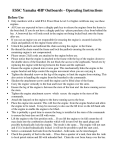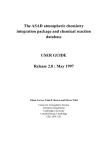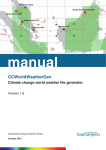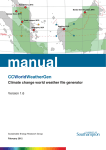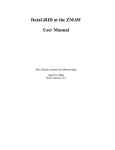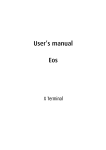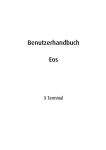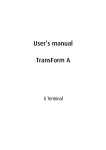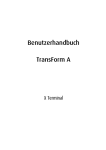Download CLoud Archive User Service User Guide - BADC
Transcript
CLoud Archive User Service User Guide Version 1.4 Authors: Gary J Robinson and Kevin I Hodges NERC Environmental Systems Science Centre The University of Reading Whiteknights Reading Berkshire RG 6 6AH © Copyright 2005 NERC Environmental Systems Science Centre Cloud Archive User Service Contents 1. OVERVIEW ...................................................................................................... 1 2. THE DATA ....................................................................................................... 2 2.1 Introduction 2 2.2 File Naming Convention 3 2.3 Image File Organisation 3 2.4 PGM Image File Format 4 2.5 Data Scaling and Geographical Arrangement 4 2.6 Quality Data Files 2.6.1 Contributing Satellites 2.6.2 Interpolation Quality 4 4 6 3. DATA PROCESSING ...................................................................................... 8 3.1 The ISCCP B3 Data 8 3.2 Processing Methodology 8 3.3 Limb Darkening and Cloud Geometry Correction 9 3.4 Quality Control of the ISCCP B3 Data 9 3.5 Accuracy of the CLAUS archive 11 4. ACKNOWLEDGEMENTS .............................................................................. 12 5. ACCESS TO THE ARCHIVE AND CONDITIONS OF USE........................... 13 APPENDICES .................................................................................................... 14 A 1 Portable Grey Map File Format 14 A 2 Monthly Animations 15 A 3 Bibliography 15 A 4 Relevant Links 16 CLAUS Project........................................................................................................................................... 16 CLAUS Consortia Members...................................................................................................................... 16 Other Links................................................................................................................................................. 16 User Guide 1.4 i Cloud Archive User Service 1. Overview The CLAUS project was supported by the European Union under the IVth Framework Programme (Environment and Climate) and ran from April 1997 to December 1999. The objectives of the CLAUS project were to produce a long time-series of global thermal infrared window (10.5-12.5 µm) imagery of the Earth and to test the feasibility of using this in validating atmospheric General Circulation Models (GCMs). The CLAUS archive currently spans the period 1st July 1983 (the start of the ISCCP period) to 31st December 1995. Responsibility for maintaining and updating the CLAUS archive resides with the NERC Environmental Systems Science Centre, Reading University, UK. Because the data have proved invaluable in validating many aspects of GCMs, and are potentially of wider use, the CLAUS archive is being made available generally through the British Atmospheric Data Centre (BADC), subject to terms and conditions of use (Section 4). The source data used in creating the CLAUS archive are the level B3 (reduced resolution) thermal infra-red radiances from the operational meteorological satellites participating in the International Satellite Cloud Climatology Project (ISCCP) and were obtained from the NASA Langley Atmospheric Sciences Data Center (LASDC). The B3 data consist of several channels (channel 1 = 0.4 µm visible, channel 2 = 10 µm thermal Infra-red ‘window’, channel 3 = 6.3 µm water vapour). The CLAUS archive at present is produced from channel 2 which is processed to create a uniform latitude-longitude gridded dataset (or image) of Brightness Temperature (TB) values at a spatial resolution of 0.5 by 0.5 degrees and temporal resolution of three hours (Hodges et al., 2000). Information (at the grid point level) about which satellites were used in generating each TB image, and the type of interpolation applied, is held in two supplementary quality files for each three-hourly TB image. The CLAUS archive is dynamic: it is continually being updated using improvements to the processing methodology and quality control of the source data. It is being extended to the end of 1999 as further data become available from ISCCP. The current status of the archive appears in the CLAUS area of the BADC web site: Table 5 outlines the differences amongst the versions. By default, data are being re-processed on a quarterly (sometimes monthly) basis, starting from 1983. However, this schedule may be modified by user requests for particular periods, so that older versions of the data may exist for some while. Recently, from version level 4.5, an additional higher resolution product (one-third degree) has starting to be produced. These data are also being used to generate monthly animations (in Quicktime format), which are proving popular for educational purposes. Both of these new datasets are being archived at BADC. The CLAUS data have been used in a number of scientific studies by the climate modelling groups involved in the CLAUS Project. These, along with details of the processing methodology, are described in the CLAUS Final Report: an edited version of this in PDF format may be downloaded from the CLAUS area of the BADC web site. CLAUS-related publications will appear in various journals over time, e.g. Yang and Slingo (2001). Further papers discussing the technical issues involved in processing the ISCCP data are in preparation. More recent scientific and technical aspects of the CLAUS project will appear in the CLAUS project area of the ESSC web server. User Guide 1.4 1 Cloud Archive User Service 2. The Data This section describes the format of the data files and how they are organised within the CLAUS archive. The data are generated and archived at two spatial resolutions: • • one-half degree – the original resolution, as used in the CLAUS project for climate model comparisons. one-third degree – started relatively recently, these data are being produced simultaneously with version 4.5 of the lower resolution data, and are intended for use in process-oriented studies, and for the creation of monthly animations for educational purposes. A brief description of how the data were generated appears in section 3. Fuller details appear in Hodges et al. (2000). Information on more recent technical developments and the quality control of the ISCCP data may be found in the CLAUS project area of the ESSC web site. 2.1 Introduction The primary data set in the CLAUS archive is a series of three-hourly Brightness Temperature (TB) images of the Earth, stored in the Portable Grey Map (PGM) format (Appendix A.1). This is a simple flat file binary format preceded by an ASCII (readable) header that contains information such as the image dimensions and version number. Figure 1 Sample half-degree resolution image from the CLAUS archive for 6/1/1992 at 21.00 UT. The leftmost column corresponds to the Greenwich Meridian and is repeated at the rightmost column. TB values are stored using an inverted greyscale (section 2.5), so that clouds appear bright. User Guide 1.4 2 Cloud Archive User Service Ancillary images provide an indication of the quality of the TB data on a per-pixel basis and are held as two separate PGM image files for each three-hourly TB image. One file acts as an index to the satellites contributing to the TB image, whilst the other denotes the type of interpolation used in deriving the TB values and the representative satellite look angles (section 2.6). 2.2 File Naming Convention Each image file in the archive is named YYYYMMDDHH.2xx, where YYYY is the year, MM is the numeric month (January=01), DD is the calendar day number and HH (00 = midnight , 03, 06, 09, 12, 15, 18, and 21) is the nominal Universal Times (UT). The xx part of the file extension denotes the data type: bt = Brightness Temperature, cs = Contributing Satellites and iq = Interpolation Quality. The ‘2’ in the file extension indicates that the data refer to ISCCP channel 2, i.e. the thermal infra-red window channel. Note that the one-half and one-third degree resolution versions of the data have the same naming convention. They are therefore held in separate directory trees - the assumption is that users will work with data at only one resolution. The Quicktime monthly animation files (Appendix A 2) are named YYYYMM_2.mov and are stored in the movies directory of the CLAUS archive under annual sub-directories. 2.3 Image File Organisation To facilitate data access, the three CLAUS products are arranged within the archive in a fourlevel directory hierarchy with the top level directory denoting the channel number (‘2’ at present1). The second level contains the lo_res, hi_res amd movies directories. The third level contains the calendar year. For the image data products only, the fourth directory contains the year plus calendar month. The file naming convention used ensures that each file name within each of the lo_res or hi_res hierarchies is unique. … channel_2 … | hi_res | (as lo_res directory) lo_res | 1983 … 1986 … 1999 | 198601 … 198604 … 19861 | … 1986040715.2bt … … 1986040715.2cs … … 1986040715.2iq … movies | 1983 … 1985 … 1999 | 198501_2.mov 198502_2.mov Figure 2: Directory structure of CLAUS archive. 1 Should further ISCCP channels be processed these data will be placed in separate directory hierarchies. User Guide 1.4 3 Cloud Archive User Service 2.4 PGM Image File Format The archived data are stored using the Portable Grey Map (PGM) image format for two reasons. First, they may be viewed directly on screens using proprietary graphics packages or widely available public domain packages (e.g. Image Magik). Second, converting the data to other formats to suit user requirements is fairly straightforward (a sample ‘C’ programme to convert CLAUS data into an ASCII format may be downloaded from the CLAUS area of the BADC site). Appendix A describes the flavour of the PGM format used in the CLAUS archive. 2.5 Data Scaling and Geographical Arrangement The (unsigned) byte data values in the brightness temperature files are mapped so that the values b=1 to 255 correspond to TB=340 to 170 K linearly, i.e.: TB = 340 – (b-1) 170/254 The value 0 is reserved to indicate points for which no value exists or for which no value can be temporally interpolated. The temperature resolution of the data is thus approximately 0.67 K. The one-half (lo_res) and one-third (hi_res) degree resolution data sets are arranged on a uniformly spaced latitude-longitude grid with values stored in row order, starting at the top left corner of the grid. The longitude of the leftmost column corresponds to 0° for both lo_res and hi_res (note that the last column is a duplicate of the first). The top row of the lo_res dataset corresponds to 89° 30’ N, and that of the hi_res dataset to 89° 40’ N. The lo_res and hi_res image sizes are thus 720 columns by 359 rows, and 1080 columns by 839 rows respectively. 2.6 Quality Data Files The quality data for both resolutions are stored as two PGM files. These contain information on a per-grid point basis about the contributing satellites (cs) and interpolation quality (iq), respectively. 2.6.1 Contributing Satellites Throughout the ISCCP period, up to seven satellites were operational simultaneously (plus INSAT-1B). More usually however, six satellites (four geostationary and two polar orbiters) were in use – the ‘nominal’ configuration - although for certain periods sometimes only four (three geostationary and one polar orbiter) were available. Because the satellite configuration changes over time the Contributing Satellite (cs) data, represented in the form of a PGM image file (A 1), are used to record which satellites were used in estimating the corresponding TB value at each grid point. This information consists of a set of eight bit flags arranged in a byte field as shown in Table 1. The bit positions are indices to a set of eight ISCCP satellite codes (Table 2), which are contained in the headers of all three PGM files for each three-hourly image (Figure 5). User Guide 1.4 4 Cloud Archive User Service Bit Position Value 1 (rightmost) 2 3 4 5 6 7 8 (leftmost) 1 2 4 8 16 32 64 128 Nominal Satellite Series NOAA Afternoon (PM) NOAA Morning (AM) GMS GOES-West (or GOES-Central) GOES-East (or METEOSAT-3 at 75°W) METEOSAT Indian Ocean (INSAT or METEOSAT-5 at 63°E) spare Table 1: Contributing Satellite flag structure. The arrangement shown is for the nominal satellite configuration, but can vary (see text). Bit flag 8 is used when the satellite configuration changes - usually when a new satellite became operational but data from the existing one was still collected (e.g. during change-over periods of the NOAA afternoon satellites). Note that some satellites changed their nominal position, for example METEOSAT-3 eventually replaced GOES-6 when this failed in 1987. For full details of the ISCCP satellite network refer to ISCCP (1987). Satellite NOAA-7 NOAA-9 NOAA-11 NOAA-14 NOAA-8 NOAA-10 NOAA-12 GOES-6 GOES-9 GOES-5 GOES-7 GOES-8 METEOSAT-2 METEOSAT-3 METEOSAT-4 METEOSAT-5 GMS-1 GMS-2 GMS-3 GMS-4 GMS-5 Designation Longitude (°) Afternoon (PM) Morning (AM) West (W) East (E) Prime Prime+GOES-E Prime Prime+63E 135W/105W 135W 75W 75W/105W 75W 0 0/75W 0 0 140E ISCCP Code Number 11 12 13 14 61 62 63 21 22 31 32 33 41 42 43 44 51 52 53 54 55 Table 2: Operational meteorological satellites used in ISCCP. The code numbers are used in the PGM image file headers (see section 2.6.1) to indicate which satellites are used in generating the TB data. User Guide 1.4 5 Cloud Archive User Service Figure 3 shows the Contributing Satellite information corresponding to the example image shown in Figure 1, expressed using a colour lookup table. Although in principle there could be 256 combinations and therefore 256 different colours, there are only about 30 combinations in reality due to constraints on the satellite positions and orbits. Figure 3: Satellite Contribution Information, corresponding to the data shown in Figure 1. Each colour represents the coverage of a single satellite or where two or more overlap. 2.6.2 Interpolation Quality The iq files are used to represent the reliability and nature of the TB interpolation employed at each grid point. Each byte in the image is split into three parts or ‘fields’, Z, I and M (Table 3). M I Z 7 6 5 4 3 2 1 0 Table 3: Structure of Interpolation Quality byte. Field Z contains the mean cosine of satellite zenith angle linearly scaled to span the range 1.0→0.1. Field I contains the sampling/interpolation level, with the values listed in Table 4. Field M is the missing data flag2 (1=missing, 0=present). If M is set then the other fields are undefined. The three fields are arranged so that the higher the combined byte value, the lower the reliability of the corresponding TB value. 2 Strictly speaking, M is redundant in the iq file since this information is available in the bt file as value 0. However, it is included in the iq file for completeness. User Guide 1.4 6 Cloud Archive User Service Value 0 1 2 3 4 5 6 7 Interpolation level primary spatial secondary spatial tertiary spatial primary temporal secondary temporal reserved reserved reserved Table 4: Values of Interpolation levels. The Z values are generally only indicative, since strictly speaking they are only defined for brightness temperature values obtained from a single satellite. Although the cosine of zenith angles are always positive for valid observations, so that mean of more than one value is also always positive, no account is taken of the distribution of the observation azimuth angles. The iq data are useful when analyses are performed on the brightness temperature data, since there are occasions where the spatial sampling of the source data is not optimal and spurious results may arise (see section 3.5). In such cases, examination of the iq data values will indicate problem regions, for example where the TB values are temporally interpolated, or where zenith angles are large (i.e. near-limb observations). Figure 4: Interpolation Quality information for the TB image shown in Figure 1. Colours denote the degree of smoothing in the spatial (red=primary, green=secondary, blue=tertiary) and temporal (magenta=primary, orange=secondary) interpolation processes. Intensity of the colour indicates the off-nadir angle (bright=nadir). Note that the majority of values are interpolated spatially at the primary , i.e. highest, resolution. User Guide 1.4 7 Cloud Archive User Service 3. Data Processing This section describes briefly the data processing used by ESSC to create the CLAUS archive. For a comprehensive account refer to the publication by Hodges et al. (2000). 3.1 The ISCCP B3 Data The ISCCP B3 source data for the project consist of two types of imagery: ‘whole earth’ images from operational meteorological geostationary satellites (METEOSAT, GMS and GOES), sampled at synoptic times corresponding to 0, 3, 6 etc. hours UT, and continuous time series of imagery from the NOAA polar orbiting meteorological satellites. The window channel is split for the AVHRR sensor on NOAA satellites 7 onwards into two channels (nominally 10.5-11.5 µm and 11.5-12.5 µm), denoted bands 4 and 5. In the ISCCP B3 dataset only band 4 is calibrated: this band, and the nominal 10 µm window channel from the geostationary satellites, are used in producing the CLAUS dataset. The combined imagery from the geostationary satellites usually provides continuous coverage up to ~75° latitudes, whilst the polar orbiter imagery covers higher latitudes and is also used to fill in where geostationary coverage is poor, e.g. the Indian Ocean region, and where data from individual geostationary satellites are absent or incomplete. The continual sampling scheme of the polar orbiters requires that these data have to be processed in such a way as to reduce their contribution with increasing time away from the synoptic times (0, 3, 6 etc. hours). 3.2 Processing Methodology The approach used in creating the data for the CLAUS archive was necessarily pragmatic due to the demands of the CLAUS project. This involved implementing a two step procedure, comprising an initial spatial interpolation of the source image data, followed by temporal interpolation to fill in gaps arising from missing source images, parts of images or regions covered only by polar orbiting satellites, i.e. the poles. Spatial interpolation onto the uniform latitude-longitude target grid is performed using spherical kernel estimators (Hodges 1998) at three levels using different kernel widths (0.5° = primary, 1.0° = secondary and 1.5° = tertiary). The level at each grid point having the highest data density is chosen to represent the brightness temperature at that point. This approach preserves the detail in the source data where present, but reduces the need for temporal interpolation in areas of low density. Temporal interpolation is then performed on those spatially interpolated three-hourly brightness temperature images that have data voids, using the two preceding and two succeeding images to estimate TB values within the data void. The level of temporal interpolation (as stored in the .iq file) is determined by which of the images ±3 or ±6 hours away have valid values in the data void of the image being processed (primary = both within 3 hours, secondary = only one within 3 hours, otherwise data point is flagged as ‘missing’). This technique works very well at low- to mid-latitudes, and reasonably well at high-latitudes due to the precessing nature of the orbits of the polar orbiting satellites. User Guide 1.4 8 Cloud Archive User Service 3.3 Limb Darkening and Cloud Geometry Correction A feature of thermal infrared imagery of the Earth, particularly from geostationary satellites, is the noticeable darkening of the image towards the Earth’s limb, so-called ‘limb darkening’. As the zenith viewing angle increases the path length through the atmosphere increases. This has two consequences. First, radiation emitted by or near to the surface is attenuated (mainly by water vapour). Second, the emission by the atmosphere itself moves preferentially to higher, cooler layers. The total radiation received is thus less than that received when viewing from nadir, and hence appears to emanate from a cooler body, i.e. it has a lower brightness temperature. Left uncorrected, limb darkening would lead to apparent discontinuities when the data from the satellites are fused together. To counteract this, a simple empirical correction is applied: L(z) = L(0) (a + b ln(cos(z)) – (1) -where: L is radiance, z is zenith angle, and a and b are empirically determined coefficients. This correction is applied to all satellites - geostationary and polar orbiters. Another zenith angle-dependent effect on observed brightness temperature is caused by the differing viewing geometries of the geostationary and polar orbiting satellites. At high zenith angles the chance of a geostationary satellite viewing through broken cloud is considerably reduced. In contrast, a polar orbiting or an adjacent geostationary satellite, viewing the same scene but closer to the nadir stands a greater chance of seeing through the cloud to the warmer surface below. To reduce this cloud geometry effect the data from both geostationary and polar orbiting satellites are down-weighted by a function similar to (1). Clearly, in regions where data from only one satellite is available this correction has no effect. 3.4 Quality Control of the ISCCP B3 Data The quality control procedures applied to both the ISCCP B3 thermal infra-red source data and the resulting CLAUS brightness temperature imagery increased in sophistication during the lifetime of the CLAUS project, and continue to be improved. As a result, the data in the archive are of several distinct levels of quality: those of a lower quality will be replaced gradually by higher quality data as the better quality control checks are applied to data as they are reprocessed. The B3 data are notionally quality controlled by ISCCP (1987). This involves identifying and flagging suspect lines in individual images, navigating each image to assign latitude/longitude values to each pixel, etc. However, ISCCP and CLAUS have different objectives in terms of products. ISCCP aims to generate monthly averaged cloud products on a per-satellite basis, whilst CLAUS aims to generate three-hourly global composite images. CLAUS therefore has a far higher reliance on accurate quality control of the B3 data than ISCCP - by definition one and half orders of magnitude greater. During the course of processing data for the CLAUS archive, it became evident that a significant fraction of the B3 data contained residual errors: poor image quality (noise), and mis-navigated images (mainly from the early GOES series). Other errors appear as mis-calibrated individual images and apparent differences between sensors from different satellites. The effects these User Guide 1.4 9 Cloud Archive User Service errors had on the original versions of the CLAUS archive were apparent when the brightness temperature images were viewed as a movie sequence (this technique has became one of the main quality control checks for the final product). The fact that these errors have been noticed only now is mainly due to the ability of the CLAUS processing system to allow data from multiple satellites to be compared simultaneously. To counteract these problems, a suite of automated procedures has been developed by ESSC for use during different stages of the data processing. The first step is to automatically identify and, where possible, remove noisy pixels and bad scan lines from each image. These are flagged, either automatically or with some user intervention in ambiguous cases, so that the corresponding data are ignored in subsequent processing. Navigation and image distortion errors are then identified automatically by noting images with spurious off-planet pixels. Initially, such images were simply rejected, but recently techniques have been developed to perform navigation correction automatically by using the imagery from the other satellites and reference coastline data sets. 1.0 Data generated by National Remote Sensing Centre under contract to ESSC as part of the CLAUS project using the ISCCP source data ‘as is’. 1.5 Data generated by ESSC, either during the CLAUS project or afterwards, with identification and removal of individual images with obvious navigation or calibration errors. 2.0 Generated by ESSC after end of project, using improved limb darkening correction techniques. 2.1 Calibration trend errors identified and corrected. 3.0 Data from geostationary satellites given temporal weighting to improve results in overlap regions. 3.5 Navigation errors in individual images identified and corrected (mainly GOES series). 4.0 Identification and correction of individual images containing rectification errors (mainly GOES-7, some METEOSAT) Identification and correction of individual images containing gross calibration errors. 4.5 Table 5: Version history of the CLAUS archive. Note: superseded versions of the data are not retained. User Guide 1.4 10 Cloud Archive User Service 3.5 Accuracy of the CLAUS archive A number of factors determine the accuracy of individual TB values within a CLAUS image: limb darkening and cloud geometry effects; time difference between source data and nominal 3-hour time; differential absorption by water vapour; sampling characteristics of the satellites/sensors; calibration errors; and the interpolation process itself. The magnitude of these errors varies and can be difficult to quantify, but as a guide they are: Limb darkening: Atmospheric absorption reduces TBs by ~10 K for clear sky regions near the limb of geostationary satellites, and up to ~3 K at the edge of polar orbiter swaths. After correction, the residual errors are estimated to be ~ 1-2 K. For cloudy scenes the near limb/swath edge error is higher (~4 K) because of cloud geometry effects. Temporal mismatch: Diurnal variation over cloud-free land (can be up to ~20 K over local Summer scenes) 3, up to ~10 K over cloudy regions due to cloud motion. Differential absorption: typically ~1-2 K differences in clear-sky moist regions between TBs from geostationary and polar orbiting satellites due to the latters’ narrower pass bands. Calibration errors: Errors in individual satellites scenes have been found of magnitude ~15 K, although these are rare and can be easily spotted and corrected. Systematic errors of up to ~ 34 K are more common; these can also be corrected, but residual errors in individual satellite images are estimated to be ~ 1-2 K. Sampling errors: The finite and different footprint sizes of the different sensors means that observations of TBs over unresolved structures is highly variable; estimated to be up to ~2-3 K. Interpolation errors: Same effect as temporal mismatch, but can be larger due to use of data from far larger time differences (i.e. up to 6 hours); estimated to be up to ~30 K in worst cases (over hot land regions in local Summer)3. These errors vary over an image due to the differing geometries of the observations, etc., but as a guide the average combined error is estimated to be ~3-4 K, although in certain regions higher values ~ 10-20 K can occur. Users of data from the CLAUS archive are strongly advised to appreciate the limitations of the data: for example, frequency analyses can sometimes produce spurious results because of the sampling characteristics of the satellites - especially the polar orbiters. 3 ERBE attempts to account for these effects by modelling the diurnal variation, and so ‘correct’ the data. This approach is not used in the CLAUS dataset at present since it might lead to unwarranted confidence in the accuracy of the data. However, such an approach might be investigated in a future product since the processing required could be applied retrospectively, i.e. to the CLAUS data product rather than having to go back to the source B3 data. User Guide 1.4 11 Cloud Archive User Service 4. Acknowledgements The CLAUS dataset could not have been created without the efforts of many people: the ISCCP team, for producing and making the B3 data available to the general community; EOSDIS, in particular the staff at the Langley DAAC, for providing a relatively painless way of accessing the large volume of data involved and sorting out various problems; and from members of the CLAUS Consortium whose feedback has been invaluable, as have comments and suggestions from users worldwide. Finally, our thanks to Murray Salby and co-workers, who proved the feasibility and utility of such a satellite derived dataset in climate applications, and provided the inspiration for the CLAUS project. User Guide 1.4 12 Cloud Archive User Service 5. Access to the Archive and Conditions of Use In order to gain access to the data, please follow the procedures set out on the BADC web site. You will then be given access to the data from an account on one of the BADC computers. In all publications relating to work using data from the CLAUS archive you are requested to include an acknowledgment of the form: ‘These results were obtained using the CLAUS archive held at the British Atmospheric Data Centre, produced using ISCCP source data distributed by the NASA Langley Data Center’. If the data provided a significant basis of the work co-authorship would be appreciated. User Guide 1.4 13 Cloud Archive User Service Appendices P5 # Type: BT (CLAUS Brightness Temperature Image Data) # Resolution: 0.5 (Half degree) # Synoptic Date: 1994061315 # Source Channel: 2 (TIR) # Satellites: 13 63 54 32 43 44 00 00 # Creation Date: 2001/10/03 13:41:26 # Revision: 4.50 (ESSC) 720 359 255 ( … <width> X <height> unsigned byte data values in sequence, starting at the top left corner of image and proceeding row-wise… ) HEADER Portable Grey Map File Format DATA A1 Figure 5: The Portable Grey Map file format used in the CLAUS archive. This example is a brightness temperature image for 1994/06/13 at 15.00 hours at one-half degree resolution. For one-third degree resolution data the resolution value is 0.3333 and the width and height are 1080 and 539, respectively. Explanation: Line 1 is the PGM ‘magic number’, denoting data are binary bytes. Lines 2-8 are PGM comment lines used to hold the following CLAUS–specific information: Resolution: Either 0.5 or 0.3333 degrees. Type: Type of data file as text string: ‘BT (CLAUS Brightness Temperature Image Data)’ ‘CS (CLAUS Contributing Satellite Image Data)’ ‘IQ (CLAUS Interpolation Quality Image Data)’ Synoptic Date: This should correspond to the file name. Source Channel: ISCCP channel number (10µm TIR in this example) Satellites: ISCCP satellite numbers (see Table 2) corresponding to the bit flags in the cs file, starting at bit 0. ‘00’ denotes that no satellite was operating at that time. Creation Date: Date and time that the TB image file was created. Revision: Version number of the data processing/Quality Control. Line 9 contains the width and height of image in grid points. Line 10 denotes the maximum possible data value (255). User Guide 1.4 14 Cloud Archive User Service A2 Monthly Animations The CLAUS monthly animations are stored in Apple’s Quicktime format, which enables them to be displayed with the same fidelity as the individual brightness temperature images, i.e. without the loss of detail that often occurs with other formats such as MPEG. To help differentiate land and ocean regions a bi-colour tint (currently red for land and blue for ocean) is applied to the brightness temperature images before they are processed to form the animations files. The date/time of each individual image is also written in the bottom right-hand corner of the corresponding frame. The Quicktime Player software that runs on Macintosh computers enables the animations to be viewed in a flexible manner, for example between selected date/time limits or in continual loops. The animations can also be paused and stepped backwards and forwards using the left and right arrow keys. To view the animations under Unix you may need to download and install suitable software, for example XAnim (http://smurfland.cit.buffalo.edu/xanim/home.html). The animations run best if the greyscale option (+Cg) is used. The animations may also be viewed on Windows PCs, but you may need to download and install the PC version of Quicktime from the Apple Web site at http://www.apple.com/quicktime (go to the ‘download’ section). A3 Bibliography Hodges, K. I., 1996: Spherical non-parametric estimators and their application to the UGAMP AMIP integration: A ten year cyclonic climatology for the northern and southern hemisphere winters. Mon. Weather Rev., 124, pp2914-2932. Hodges, K., D.W. Chappell, G.J. Robinson and G. Yang, 2000: An improved algorithm for generating global window brightness temperatures from multiple satellite infra-red imagery. J. Atmos. And Ocean Tech., 17, 1296-1312. Rossow, W. B., A. Walker and M. Roiter, 1997: International Satellite Cloud Climatology Project (ISCCP): Description of Reduced Resolution Radiance Data. WMO/TD-No. 58, World Meteorological Organization, Geneva. Salby, M. L., H. H. Hendon, K. Woodberry and K. Tanaka, 1991: Analysis of global cloud imagery from multiple satellites. Bull. Am. Met. Soc., 72, 467-480. Yang, Gui-Ying, Julia Slingo, 2001: The Diurnal Cycle in the Tropics. Monthly Weather Review, 129, No. 4, 784–801. User Guide 1.4 15 Cloud Archive User Service Cheruy, F., R. S. Kandel and J. P Duvel, (1991): Outgoing longwave radiation and its diurnalvariations from combined Earth Radiation Budget Experiment and Meteosat observations .2. Using Meteosat data to determine the longwave diurnal cycle. Journal of Geophysical Research-Atmospheres, 96(D12), 22623-22630. A4 Relevant Links CLAUS Project Web Server: http://www.nerc-essc.ac.uk/CLAUS CLAUS Consortia Members ESSC: http://www.nerc-essc.ac.uk/ UGAMP: http://ugamp.nerc.ac.uk/ CNRM: http://www.meteo.fr/ LMD: http://www.lmd.ens.fr/ MPI: http://www.mpimet.mpg.de/ ECMWF http://www.ecmwf.int/ Other Links BADC: EOSDIS: ISCCP: Hadley Centre: User Guide 1.4 http://www.badc.rl.ac.uk/ http://spsosun.gsfc.nasa.gov/eosinfo/EOSDIS_Site/index.html http://isccp.giss.nasa.gov/ http://www.meto.govt.uk/research/hadleycentre/ 16


















